
The European market potential for agritourism
Agritourism is popular amongst a wide base of travellers who seek authentic, immersive experiences where they can learn about and engage with traditional farming practices. Food and wine tours and farm tours are especially popular. Nationals from European countries like France, the Netherlands and Germany offer good opportunities for agritourism providers as they like to travel to the countryside and remote places where agritourism experiences are found. Sustainability is the major trend in agritourism, and embedding responsibility in agritourism businesses is essential.
Contents of this page
1. Product description
Agritourism is a type of travel experience that focuses on exploring food and agricultural products that are unique to a particular region. It involves activities such as visiting farms, vineyards, orchards and food production facilities to learn about the cultivation, production and processing of local food and beverages. Agritourism can be defined as tourism where ‘tourists plan their trips partially or totally to carry out activities related to agriculture, including the enjoyment of an agricultural setting’.
Agritourism has opportunities for visitors to participate in activities like harvesting crops, tasting local specialties, cooking traditional dishes, and attending food festivals or farmers’ markets. It allows travellers to immerse themselves in the local food culture, interact with producers and artisans, and gain a deeper understanding of the connection between food, culture and the environment.
Agritourism is a specialist niche within the ecotourism niche. Ecotourism is part of the wider nature tourism segment. Agritourism is also closely aligned with community-based tourism (CBT) and cultural and heritage tourism in rural settings, and is related to other niche markets like food and drink tourism, walking tourism and fishing tourism.
Figure 1: What is agritourism?
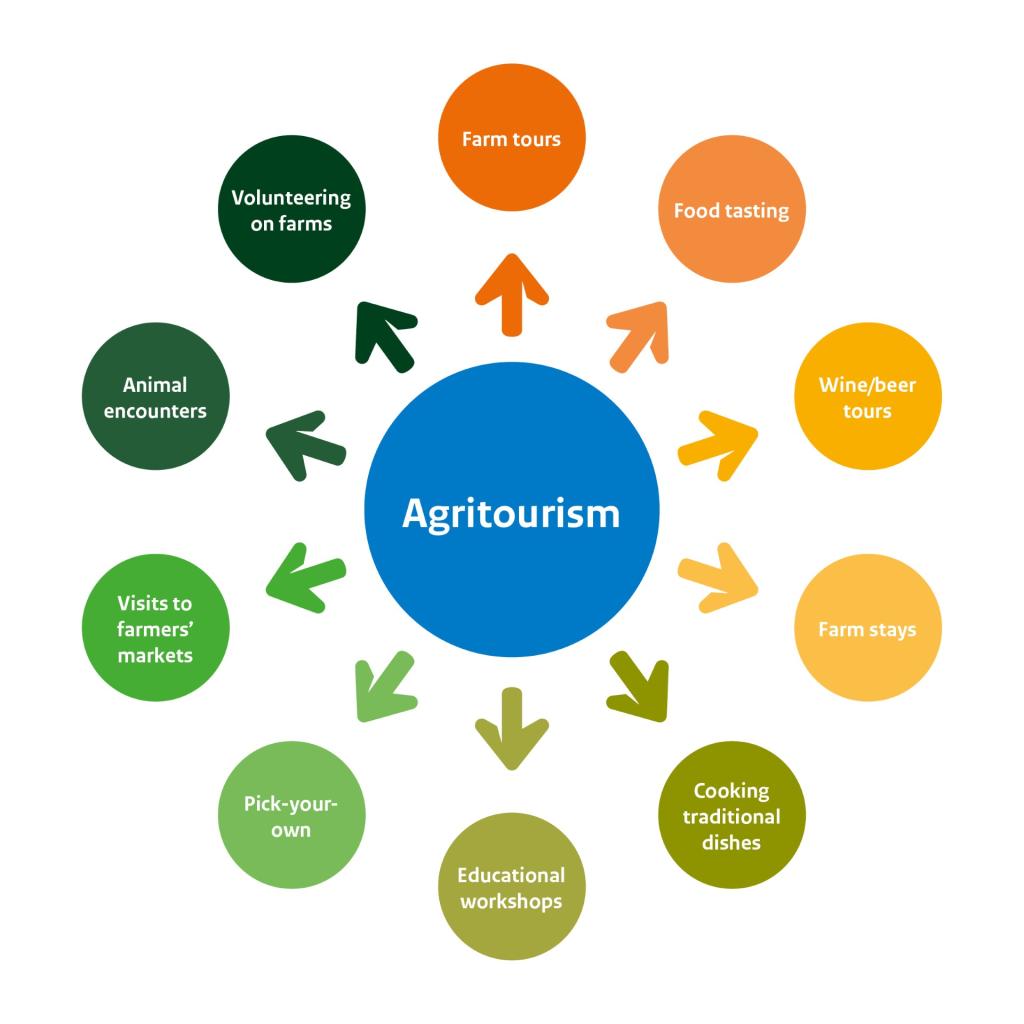
Source: Acorn Tourism Consulting, 2024
Agritourism evolved from the main business of farming. As the farming sector experienced difficulties and declines over past years, farmers began to look for ways to diversify activities to create an alternative income stream. Providing tourism experiences that showcase farming activities has become the most common and successful way for the farming industry to diversify. However, there are many other benefits for agritourism providers beyond income generation:
- Promoting agritourism can help small-scale farmers and producers attract more visitors to rural areas.
- Agritourism fosters sustainable practices by encouraging the preservation of traditional farming methods and promoting local food and wine.
- Agritourism helps raise awareness about the importance of biodiversity and environmental conservation.
- Agritourism can help address depopulation of the countryside by providing economic stability that encourages more people to stay, particularly the younger generations.
- As agritourists stay longer in a region, they may spend more on other local businesses like restaurants and local artisans.
- Agritourism can also help address seasonality as farms can often be visited year-round when different activities and processes take place.
Agritourism is quite varied. Generally, it depends upon the farming practices of a particular region or area. An outline of the different agritourism types is listed in the table below.
Table 1: Agritourism types
| Agritourism types | Details |
| Farm tours | Tours of farms growing or manufacturing local produce that is typical of an area or region, e.g. coffee, tea, cacao, dates, honey, cheese, meat, olive oil. Visitors learn about the farm’s operations, history and produce. This might include tours of crop fields, orchards, livestock areas and processing facilities. Farm tours are amongst the most common types of agritourism activities. |
Food-tasting activities | Food-tasting experiences are often linked to a farm tour, like cheese tasting or a chocolate tour. Wineries and breweries can also include food experiences in their offering. Food and drink tastings are amongst the most popular agritourism experiences on the market today. |
| Wine, distillery and brewery tours | Wineries and breweries located in rural areas commonly offer tours and tastings. Visitors learn about the production process and sample local wines, beers and spirits. Visits to vineyards and wineries are very popular and common in wine regions all over the world. |
Farm-to-table eating experiences | Guests enjoy meals prepared at the farm made with fresh, local ingredients sourced directly from the farm, like meat, cheese, vegetables, herbs, fruit. |
| Farm stays (also known as homestays) | Some farms offer accommodations for overnight guests to allow them to experience rural life firsthand. Accommodations might be in guesthouses or cottages, or camping facilities. Sometimes the farm stay offers guests the opportunity to partake in farming activities like caring for animals or harvesting crops. |
Cooking traditional dishes | Cooking experiences are often created as part of a rural tourism experience and may be common while on a farm/home stay. People usually learn about local dishes and ingredients and may share a meal with the local family. Sometimes a visit to a local market to buy ingredients is included. |
Educational workshops | Some farms may offer educational workshops and classes on topics like gardening, cooking, cheese-making, beekeeping, and sustainable farming practices. |
Pick-your-own | Pick-your-own involves trips to farms to pick seasonal fruit and vegetables for personal consumption. These experiences tend to be seasonal and are especially popular with the family market. |
| Pesca-tourism | Pesca-tourism experiences involve learning about local fishing practices and fishing with local fishers to supply communities and markets with locally caught fish. |
| Visits to farmers’ markets | Farmers’ markets in rural areas provide opportunities for visitors to purchase fresh, locally grown produce, artisanal foods, crafts and other products directly from farmers and producers. |
| Animal encounters/petting zoo | Some farms have an area where visitors can encounter farm animals like cows, sheep, pigs, goats, llamas, chickens and ducks. This type of agritourism is particularly popular amongst families with young children. |
| Volunteering on farms | Volunteering on a local farm for a few days or weeks, or longer, are common experiences for people on a gap year or looking for an immersive longer-term experience. |
Source: Acorn Tourism Consulting, 2024
Examples of agritourism experiences
Agritourism experiences are based around what is commonly practiced in a particular region or area. Many are booked directly with the provider or through specialist agritourism online travel agents (OTA). The table below provides a selection of agritourism experiences on the market.
Table 2: Examples of agritourism trips and experiences on the market, 2024
| Agritourism experience | Details |
Horseback riding coffee farm tour with coffee spa, Colombia Type: Farm tours | A 5-hour trip that includes a tour of a coffee farm to see how coffee is cultivated, harvested and processed into coffee beans. |
Day tour to Kiambethu Tea Farm, Kenya Type: Farm tours, Farm-to-table eating experiences | This day trip involves drinking tea while hearing the history of the farm and the process of cultivating tea. Visitors walk in the indigenous forest to identify plants and learn how they are used, plus see the resident colobus monkeys. Lunch is prepared using vegetables from the garden and cream from a herd of Channel Island cows. |
Farm to table at an eco-farm, India Type: Farm-to-table eating experiences, Cooking traditional dishes | A culinary adventure with a Rajasthani community with hands-on learning traditional preparation of local food and partaking in the daily activities of an eco-farm. It also involves harvesting produce to eat during the meal.
|
Regenerative farming and local gastronomy, Jordan Type: Farm tours, Farm-to-table eating experiences | This tour includes a 90-minute seminar and tour of the farm to find out how the farm has used regenerative techniques to restore the land to be suitable for farming. A 5-course meal is served using locally sourced ingredients. |
Alpaca and Llama Farm Tour, Perú Type: Farm tours | A part-day trip to a llama farm outside Cusco to view different varieties of llamas and alpacas, learning the ancient history of the animals and how they became domesticated. See how the local people practice weaving to produce the famous textiles. |
Help grow mushrooms and experience local Vietnamese culture Type: Volunteering on farms | This volunteering experience involves 25 hours per week volunteering, sleeping in a shared dormitory with meals provided. Activities include planting crops, sowing seeds and helping with outdoor tasks. |
Beekeeping, Jordan Type: Farm tours | A tour around the beekeeping site that includes an informative presentation and interaction with the hives in a full protective beekeeping suit. |
Wineries of Chile, Argentina, Uruguay and Brazil Type: Wine, distillery and brewery tours | A 12-day tour to sample and learn about different wine cultures in four South American countries, including the two lesser-known wine destinations of Uruguay and Brazil, plus general sightseeing. |
Type: Farm tours | A 13-day tour of northeastern Tanzania, with several farm visits including avocado, coffee, maize production and livestock; there is also a Big 5 jeep safari.
|
Farm to Farm – Mexico and Cuba Type: Farm tours | A 20-day cultural and agritourism tour with farm visits that include coffee, tobacco, sugar, organic fruits and vegetables like avocado and corn. Cuba is known for its sustainable farming practices and has a thriving farm-to-table culture. |
Source: Acorn Tourism Consulting, 2024
End-market segmentation and consumer behaviour
Agritourism is dominated by domestic tourists who want to connect with their own rural culture and farming traditions, although their interest in rural tourism is likely to extend to international travel.
Types of agritourists and their characteristics are outlined as follows:
- Nature Enthusiasts: Many agritourists have a deep appreciation for the natural world. They enjoy spending time outdoors, exploring rural landscapes and connecting with nature. Agritourism allows them to immerse themselves in the beauty of the countryside and experience the rhythms of farm life.
- Food Lovers: Agritourism appeals to people who are passionate about food and where it comes from. They enjoy learning about different farming practices, tasting fresh, locally grown produce, and experiencing the farm-to-table journey firsthand. This group also includes people interested in the production and tasting of wine, beer and distilled spirits like whisky. Agritourism gives them an opportunity to indulge in culinary delights and support sustainable agriculture.
- Families: Agritourism is a popular choice for families looking for educational and recreational activities that everyone can enjoy together. Children love the hands-on experiences offered by agritourism, such as picking fruits, feeding animals, and participating in farm tours and workshops.
- Adventure Seekers: Some agritourism activities can be more adventurous, like hiking through orchards, participating in farm chores, and horseback riding on a ranch or farm. These adventure tourists are drawn to the excitement and challenge of exploring rural landscapes and trying new experiences.
- Environmentalists: Agritourism also attracts people who are concerned about environmental issues and interested in supporting sustainable farming practices. They see agritourism as a way to connect with local farmers who value environmental management, conservation and biodiversity.
- History and Culture Lovers: For people interested in history, culture and heritage, agritourism offers opportunities to learn about traditional farming methods, local customs and rural traditions. They enjoy exploring historic farmsteads, visiting agricultural museums, and interacting with farmers who preserve and celebrate their cultural heritage.
Agritourists can also be segmented by generation and life stage, as shown the infographic below.
Figure 2: Agritourists by life stage

Source: Acorn Tourism Consulting, 2024
Accessible tourism on the European market
Accessible tourism is the ongoing endeavour to ensure tourist destinations, products and services are accessible to all people, regardless of physical limitations, disabilities or age. It encompasses publicly and privately owned tourist locations. The improvements benefit not only those with permanent physical disabilities, but also parents with small children, elderly travellers and people with temporary injuries such as a broken leg, as well as their travel companions. Disabled tourists may travel individually, in groups, with their family or with carers.
Accessibility and agritourism
People with disabilities also enjoy a wide range of tourism experiences, including agritourism activities. However, accessibility in rural destinations is often more challenging for people with disabilities. It is important to remember that the disabilities are not always seen. In fact, wheelchair users account for just 7% of people with disabilities. Bear in mind that older people, the largest market for agritourism, may also have specific needs.
Many people with disabilities are likely to visit rural destinations with able-bodied family and/or friends. But you should assess how friendly your business is for those with disabilities. Things to consider for this market:
- If you run farm tours, pay attention to where people walk. If the ground is uneven or involves steps and hard-to-reach places, your marketing materials must mention this clearly.
- If you are planning any new paths or experiences, think about how you can cater to this market.
- Train your staff so they know how to support people with disabilities when they visit your site.
- Make sure your bathroom facilities are suitable for visitors, according to need. Part of catering to wheelchair users is having suitable bathroom facilities.
- Be very clear about how you cater to people with disabilities. If you cannot cater to disabled people, say so. Include details in all your marketing, also in your website.
Tip:
- Read the CBI studies The European market potential for accessible tourism and Entering the European market for accessible tourism for practical and useful advice to make your tours accessible.
2. What makes Europe an interesting market for agritourism?
Europe is an interesting market for agritourism because Europeans like to travel to rural destinations. Europeans have a growing desire for real experiences that are authentic and unique. Agritourism experiences are increasingly popular on the European market.
Agritourism is growing. The global value of the sector was estimated to be US$69.24 billion in 2019. Its market value is projected to rise to $197.37 billion by 2032, representing a CAGR (compound annual growth rate) of 8.8% during the forecast period. Growth is being driven by a rise in diversification of farmers’ activities, alongside a rising demand for travel to learn and experience unique and different cultures. The demand for sustainability and ecotourism is also expected to drive growth.
In Europe, 42.3% of European tour operators are active in the ecotourism niche, one that is closely aligned with agritourism.
Research conducted by CBI amongst top European source markets in 2022 found that 40% of respondents liked going to the countryside regularly and 39% visited small towns, villages and rural communities. Agritourism is often practiced in or around rural places like these. A further 25% of respondents often travelled to remote destinations, and 23% to very remote, off-the-beaten-track locations.
Source: CBI 2022
3. Which European countries offer the most opportunities for agritourism?
The European countries offering the most opportunities for agritourism in developing destinations are France, Netherlands, Germany, Spain, the UK and Italy. They are the largest outbound European source markets, and have strong connections with and interest in their own agricultural heritage. They also have a strong motivation to travel and visit small communities and remote destinations where agritourism is common. Due to the rural nature and alignment with nature tourism, Belgium, Poland and Czechia are also interesting markets to consider for agritourism.
France
French outbound tourists appreciate agriculture, food and rural experiences, which reflects the country’s own culture. According to CBI research, they have the highest desire amongst the source markets to make the countryside part of their trip (46%) and are also keen to visit small towns, villages and communities (47%), more remote places (33%) and off-the-beaten-track destinations (30%).
As the world’s second-largest leading wine producer after Spain, French agritourists also like to visit vineyards and wineries abroad to learn about different winemaking techniques and taste local wines. They are drawn to culinary experiences, including farm-to-table dining, cooking classes, food markets and learning about traditional cooking methods.
Figure 4: Visiting vineyards are popular agritourism activities for Europeans
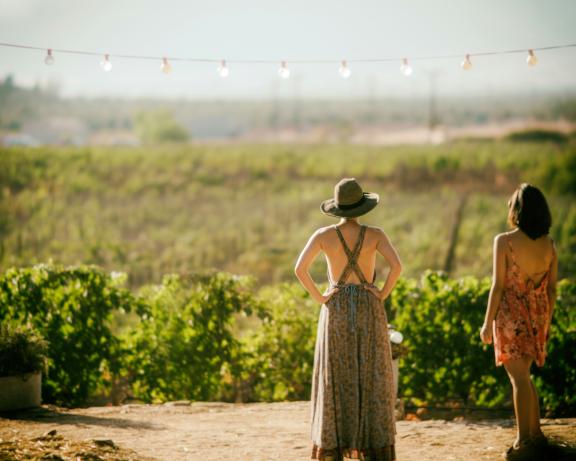
Source: Armando Castillejos at Unsplash, 2016
The French are especially concerned with sustainability, which is an essential component of agritourism. They are more likely to pay extra for sustainable travel options than other Europeans, and are increasingly choosing to travel less but stay longer in a destination. French tourists also have strong preferences on sustainability, which are key indicators for agritourism:
- They like to consume locally sourced products while on holiday (52%)
- They take steps to reduce waste while on holiday (45%)
- They like to know that more of their money directly benefits local communities (39%)
They often prefer to go on holiday outside the main tourist season (39%)
Beyond Europe, Africa is the most popular destination for French tourists – Morocco was the top destination, likely as French is one of the languages spoken there. Other popular developing country destinations for French outbound tourists in 2021 were Tunisia, Turkey and Thailand. French-speaking destinations like Madagascar and Senegal are also favoured by French outbound tourists. These are all potential destinations for agritourism.
The Netherlands
The Dutch are equally interested in spending time in the countryside compared to the French (46%), as they have a strong appreciation of agriculture, nature and rural life: 39% indicated a preference for frequent visits to small villages, towns and communities, 24% to remote destinations and 21% to off-the-beaten-track places.
Food, wine and beer experiences play a large part in agritourism for Dutch travellers, and they have a strong interest in ecotourism and nature conservation. They seek agritourism experiences that promote environmental sustainability and support conservation efforts. They are amongst the most sustainable of the European source markets – over half (53%) of Dutch tourists state they will think more about sustainability and environmental impact when planning a holiday.
Figure 5: Dutch travellers are sustainably minded
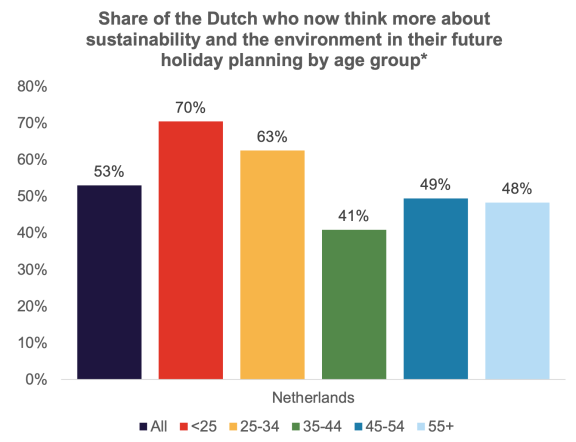
Source: Visit Britain, 2021
The Dutch like to take practical actions to travel sustainably, and aim to:
- take holidays outside the main tourist season (45%)
- eat locally sourced products while on holiday (44%)
- reduce waste while on holiday (44%)
- travel to less-visited destinations (43%)
The most popular developing country destinations for Dutch nationals are Turkey, Thailand, Morocco, Egypt and Indonesia. Other countries they like to visit are the Asian destinations of Malaysia, Vietnam and India.
Germany
Germany is Europe’s largest outbound travel market. According to CBI research, German travellers like to visit countryside destinations more often than the average (45%): 29% state they frequently go to small villages, towns and communities, where agritourism is popular; 19% often visit remote areas and 17% off-the-beaten-track destinations.
Germans have a strong preference for nature and outdoor activities and seek agritourism experiences that allow them to explore scenic landscapes and take part in outdoor activities. Domestic research shows that relaxation (65%), recuperation (64%) and enjoying nature (56%) are top motivations for German nationals, all compatible with agritourism.
However, there are some differences amongst German travellers. Luxury travellers from Germany are less likely to be interested in rural or countryside holidays than non-luxury travellers, unless there is something unique to attract this group, such as a luxury ecolodge.
Like the other source markets, Germans care about sustainability and are increasingly looking to minimise their travel impact:
- 54% of German travellers would choose locally sourced food and drink products while on holiday
- 47% would be prepared to pay to protect the local environment
- 45% planned to reduce waste while on holiday
- 43% would travel to less-visited destinations
Turkey is the most popular developing destination for German tourists, accounting for 7.9% of all outbound trips. Other popular destinations are Egypt, Thailand, Morocco and South Africa. Places where German is spoken, like Namibia, are also appealing to Germans.
Spain
Like other source countries, Spanish agritourists are drawn to rural areas to connect with nature, appreciate agricultural traditions and enjoy local cuisine. While 41% state they like going to the countryside frequently, 50% frequently visit small towns, villages and communities, the highest of all the source countries. Being typical destinations for agritourism, this suggests that Spanish travellers are a key source market.
Spanish nationals are known for their appreciation of local cuisines and wines – Spain is the third largest wine producer in the world. As in France, they like to travel to experience wine and food from other countries, learn different techniques and sample new produce. Rural and nature destinations are Spaniards’ second-favourite holiday destinations (17%) after the beach.
Spanish people are amongst the most sustainably minded of the source markets. They are keen to minimise their travel footprint – 71% said they preferred to consumer locally sourced products while on holiday. Other sustainability actions include:
- Reducing waste on holiday (68%)
- Taking holidays outside the main tourist season (53%)
- Travelling to less-visited destinations (52%)
- Reducing water usage while on holiday (52%)
- Contributing to carbon-offsetting activities (52%)
Although Morocco is the top destination for Spaniards, Spanish-speaking countries like Mexico, Colombia and Costa Rica are also popular.
Figure 6: Tea plantations in India are destinations for agritourism
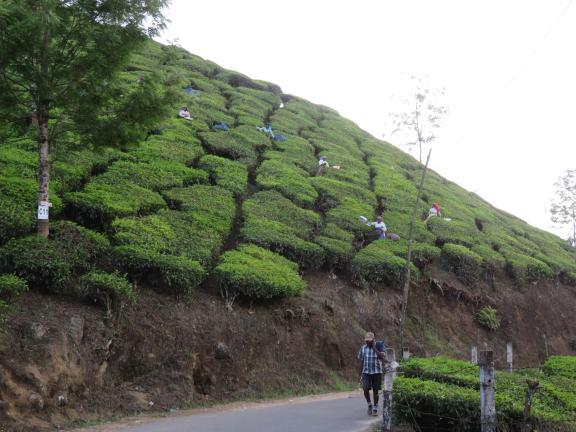
Source: Acorn Tourism Consulting, 2019
The United Kingdom (UK)
CBI research amongst British tourists found frequents visit to the countryside (32%) and to small towns, villages and communities (31%). Regular travel to remote and off-the-beaten-track destinations accounted for 19% and 17% of respondents, respectively. Attitudes towards agriculture and sustainability have been changing over the past few years, as British consumers increasingly appreciate farming’s vital role in the country’s culture and food heritage.
As a result, interest in rural tourism in the British market is growing by a 7% point rise. Glamping and camping on farms are some of the most popular agritourism experiences enjoyed by British consumers. Additional research about travel intention in the UK found that 84% wanted suggestions for quieter alternatives than touristic hotspots. This finding was the same across all generations, further confirming these trends.
British tourists are also sustainably minded, with 86% of respondents stating that sustainability is important to them when choosing a holiday destination. Other research revealed that 32% of British travellers avoid flying altogether on account of environmental concerns, and 62% would use more sustainable forms of transport (such as trains) if they were cheaper. Busy destinations are avoided by 59%, who are more interested in travelling to lesser-known places.
Turkey, India, Mexico, Morocco, South Africa and Thailand are the top developing destinations for British travellers.
Italy
Italians are particularly interested in agritourism. Italian culture is heavily influenced by agriculture – Italy is the world’s leading wine producer, an important olive oil producer, and famous for its cuisine. The Slow Travel movement also originated in Italy, a concept that emphasises travelling slowly through a destination, taking time to get to know a place, connecting with the local culture and minimising the environmental impact of travel. Slow travel is closely linked to agritourism.
This is why Italians feel a strong connection with nature. CBI research found that 29% of Italian travellers frequently go to the countryside, with 38% inspired to visit small towns, villages and communities. Remote destinations and places off the beaten track were visited by 24% and 23%, respectively.
As a nation of foodies, Italians are particularly keen to consume locally sourced produce when on holiday (42%). They also like to travel off the main tourist season (27%). Egypt, Turkey, Morocco and Thailand are leading developing destinations for outbound Italian tourists.
Tip:
- To find out more about European source markets, read the CBI demand study What is the demand for outbound tourism on the European market?.
4. Which trends offer opportunities or pose threats in the European agritourism market?
Sustainability is the key trend in agritourism, and providers must embed responsible practices into their businesses. Following the pandemic, rural tourism has become more popular as people’s desire for secluded, authentic and nature-based experiences has grown. Agritourism experiences have therefore become highly sought after. Assuring suitable infrastructure and incorporating digitalisation are likely to be the biggest challenges for agritourism providers in very remote destinations.
Sustainability is a key trend for agritourists from Europe
Sustainability has emerged as a key trend in agritourism, attracting European agritourists who are very conscious of environmental and social issues. Sustainability is shaping agritourism businesses in several ways:
- Eco-friendly farming practices: farms are increasingly using sustainable farming methods to minimise environmental impact. This includes organic farming, regenerative practices to improve soil, crop rotation and using less chemicals. Visitors are often interested in seeing these practices in action and understanding their benefits for the environment.
- Conservation efforts: many agritourism businesses focus on conserving natural resources and biodiversity. This can involve preserving natural habitats, protecting endangered species and maintaining soil health – these are also known as regenerative practices. Tourists can participate in conservation activities, such as planting trees or engaging in wildlife monitoring.
- Renewable energy use: many farms now use renewable energy sources like solar, wind and biomass. This not only helps promote sustainability but is also educational for visitors, who can learn about green energy solutions.
- Sustainable accommodations: eco-friendly farm/homestays, cabins and camping sites are becoming more popular. These accommodations are designed to have minimal environmental impact by using sustainable materials, energy-efficient systems and water conservation measures.
- Local and organic food: agritourism often includes farm-to-table experiences, where visitors can enjoy meals made from locally sourced, seasonal and/or organic ingredients. This trend supports local farmers, reduces food miles, and ensures that guests consume fresh and nutritious produce.
- Education and awareness: sustainability in agritourism is also about educating visitors. Farms offer workshops, tours and interactive experiences that teach about sustainable farming practices, environmental stewardship and the importance of supporting local agriculture.
- Community engagement: agritourism can play a vital role in sustaining rural communities by providing economic opportunities and fostering a sense of community. Visitors are often encouraged to engage with local traditions, crafts and culture, promoting a deeper appreciation for rural life and contributing to local economies.
- Waste reduction and water conservation initiatives: reducing waste and conserving water are important parts of sustainable agritourism. Composting organic waste, putting in place recycling schemes, and minimising single-use plastics are ways to reduce waste. Rainwater harvesting, drip irrigation and the use of drought-resistant crops help to ensure water is used efficiently and responsibly.
- Green transportation options: to lower the carbon footprint associated with travel, some agritourism operators promote the use of public transportation and carpooling, and even offer electric vehicle charging stations. They may also organise shuttle services for groups to reduce individual car use.
The Belmont Estate in Grenada exemplifies a farm that operates under fully sustainable principles. Agritourism experiences include tree-to-bar chocolate making, an organic farm tour and a goat dairy tour. It practices organic regenerative farming to maximise the health of soil, restore ecosystems and enhance biodiversity. They have a strong sense of duty to the local community and staff, treating them respectfully and fairly, and have implemented a ‘pledge to nature and our people’.
Figure 7: Belmont Estate’s Pledge to nature and people
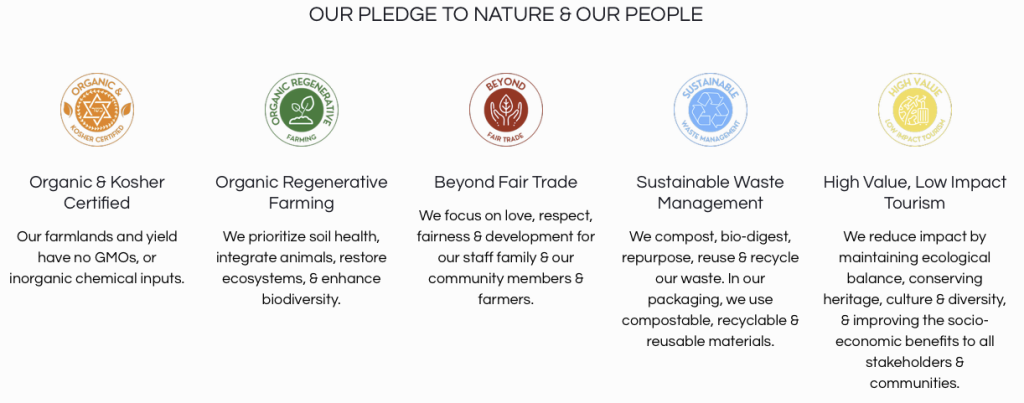
Source: Belmont Estate, 2024
It is thus clear that agritourism providers that embed sustainable practices will be able to reduce their environmental impact plus attract a growing segment of eco-conscious European agritourists who seek authentic, responsible and educational travel experiences.
Tips:
- Assess the sustainability actions of your business and take measures to make changes where you can. As a start, you can limit single-use plastics, implement recycling and waste management programmes, and provide locally grown and seasonal produce. The CBI study 10 tips to go green in the tourism sector is a helpful tool.
- Become sustainably certified so that you can provide extra reassurance to European agritourists on your commitment to sustainability. If you cannot become certified right now, be sure to talk extensively about your sustainability actions on your website. See how Belmont Estate gives very detailed information about sustainability, although it does not have certification.
- Find out more about sustainability certification in the CBI study How to be a sustainable tourism business.
Demand for authentic and unique rural experiences rises amongst a broad audience
The higher interest in agritourism experiences and rural escapes in all the source markets reflects a clear shift towards more sustainable, authentic and experiential ways to travel. This can be seen in combination with the increased desire to explore the cultural and natural heritage of rural areas through traditional farming methods and activities.
More people are moving away from mass tourism to avoid the exploitation of resources and communities, and the commercialism of tourism. Overtourism is a particular problem in lots of popular destinations, and the experience for locals, places and visitors can be at best disappointing and at worst destructive and damaging. It is not at all sustainable and consumers are increasingly aware of this.
Agritourism experiences that are properly managed offer a good solution to mass tourism. Small-scale, intimate, personal and authentic agritourism provides the opportunity to experience something unique while giving something back to the world.
Tip:
- Keep your tour sizes small. This will enhance the authenticity of the tour and allow visitors to fully take part. The more personal you can make your tour, the better reviews you will receive, which will attract more visitors.
Infrastructure, digitalisation and lack of skills are main challenges
59% of UN Tourism member states consider rural tourism to be a priority, and almost all (93%) believe there is a good future for rural tourism. Creating new jobs and protecting livelihoods as well as preserving and promoting cultural heritage and the environment are identified as the key benefits to communities.
However, there is a series of challenges that may affect rural tourism providers, including those that offer agritourism:
- Infrastructure challenges: poor or inaccessible roads may make it difficult for visitors to reach the site. A lack of other resources like reliable electricity or water may also have an impact on agritourism development.
- Lack of digitalisation: it can be expensive for small businesses to incorporate digitalisation into their operations. Broadband connections in rural areas are often much slower than in city/town destinations. The trend for researching and booking online is accelerating. Agritourists, like many other niche markets, like to research and book online. This may hinder agritourism development for some types of tourists, like digital nomads.
- Rural depopulation: young people leaving the countryside for economic reasons or off-season may impact the year-round availability of agritourism products.
- Lack of education/skills: providing well-trained staff and retaining them in the face of other challenges is a key factor.
It will be important for agritourism providers to keep up with any developments planned for their region, and lobby tourism boards and local governments for change. At the same time, they must bear in mind that any developments must be undertaken under sustainable principles to minimise negative impacts on people, places and planet.
Tips:
- Consider how to make your business more digital. The CBI study 10 tips to go digital in the tourism sector is a helpful tool.
- Find out more about trends in tourism that impact tourism niches, including agritourism, and read the CBI study What trends offer opportunities or pose threats on the European outbound tourism market?.
Acorn Tourism Consulting Limited carried out this study on behalf of CBI.
Please review our market information disclaimer.
Search
Enter search terms to find market research
